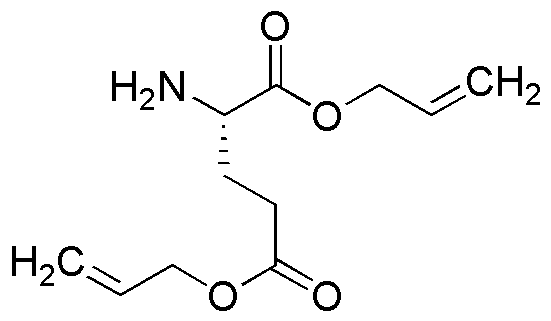L-Glutamic acid diallyl ester tosylate is widely utilized in research focused on:
- Biochemical Research: This compound serves as a valuable reagent in synthesizing various peptides and proteins, aiding researchers in understanding protein interactions and functions.
- Drug Development: It is used in the formulation of drug delivery systems, enhancing the bioavailability of therapeutic agents, which is crucial in developing effective medications.
- Agricultural Chemistry: The compound can be employed in creating bio-stimulants for crops, promoting growth and resistance to stress, thus benefiting agricultural productivity.
- Polymer Chemistry: It acts as a cross-linking agent in polymer synthesis, improving the mechanical properties of materials used in coatings and adhesives.
- Cosmetic Formulations: This ester is incorporated into skincare products for its moisturizing properties, providing a smooth texture and enhancing product performance.
General Information
Properties
Safety and Regulations
Applications
L-Glutamic acid diallyl ester tosylate is widely utilized in research focused on:
- Biochemical Research: This compound serves as a valuable reagent in synthesizing various peptides and proteins, aiding researchers in understanding protein interactions and functions.
- Drug Development: It is used in the formulation of drug delivery systems, enhancing the bioavailability of therapeutic agents, which is crucial in developing effective medications.
- Agricultural Chemistry: The compound can be employed in creating bio-stimulants for crops, promoting growth and resistance to stress, thus benefiting agricultural productivity.
- Polymer Chemistry: It acts as a cross-linking agent in polymer synthesis, improving the mechanical properties of materials used in coatings and adhesives.
- Cosmetic Formulations: This ester is incorporated into skincare products for its moisturizing properties, providing a smooth texture and enhancing product performance.
Documents
Safety Data Sheets (SDS)
The SDS provides comprehensive safety information on handling, storage, and disposal of the product.
Product Specification (PS)
The PS provides a comprehensive breakdown of the product’s properties, including chemical composition, physical state, purity, and storage requirements. It also details acceptable quality ranges and the product's intended applications.
Certificates of Analysis (COA)
Search for Certificates of Analysis (COA) by entering the products Lot Number. Lot and Batch Numbers can be found on a product’s label following the words ‘Lot’ or ‘Batch’.
*Catalog Number
*Lot Number
Certificates Of Origin (COO)
This COO confirms the country where the product was manufactured, and also details the materials and components used in it and whether it is derived from natural, synthetic, or other specific sources. This certificate may be required for customs, trade, and regulatory compliance.
*Catalog Number
*Lot Number
Safety Data Sheets (SDS)
The SDS provides comprehensive safety information on handling, storage, and disposal of the product.
DownloadProduct Specification (PS)
The PS provides a comprehensive breakdown of the product’s properties, including chemical composition, physical state, purity, and storage requirements. It also details acceptable quality ranges and the product's intended applications.
DownloadCertificates of Analysis (COA)
Search for Certificates of Analysis (COA) by entering the products Lot Number. Lot and Batch Numbers can be found on a product’s label following the words ‘Lot’ or ‘Batch’.
*Catalog Number
*Lot Number
Certificates Of Origin (COO)
This COO confirms the country where the product was manufactured, and also details the materials and components used in it and whether it is derived from natural, synthetic, or other specific sources. This certificate may be required for customs, trade, and regulatory compliance.


